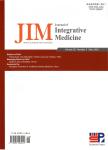A homeopathic nosode, Hepatitis C 30 demonstrates anticancer effect against liver cancer cells in vitro by modulating telomerase and topoisomerase Ⅱ activities as also by promoting apoptosis via intrinsic mitochondrial pathway
A homeopathic nosode, Hepatitis C 30 demonstrates anticancer effect against liver cancer cells in vitro by modulating telomerase and topoisomerase Ⅱ activities as also by promoting apoptosis via intrinsic mitochondrial pathway作者机构:Cytogenetics and Molecular Biology Laboratory Department of Zoology University of Kalyani Life Force411 Krushal Commercial Complex
出 版 物:《Journal of Integrative Medicine》 (结合医学学报(英文版))
年 卷 期:2016年第14卷第3期
页 面:209-218页
核心收录:
学科分类:1004[医学-公共卫生与预防医学(可授医学、理学学位)] 1002[医学-临床医学] 100214[医学-肿瘤学] 100401[医学-流行病与卫生统计学] 10[医学]
基 金:University Grants Commission UGC
主 题:formularies,homeopathic antineoplastic agents telomerase DNA topoisomerases,type Ⅱ membrane potential,mitochondrial
摘 要:OBJECTIVE: Homeopathic nosodes have seldom been scientifically validated for their anticancer effects. This study was conducted to examine if a recently developed hepatitis C nosode has demonstrable anticancer potential in cancer cells in vitro.METHODS: Anticancer effects of Hepatitis C 30C(Hep C 30), if any, were initially tested on three cancer cell lines, HepG2(liver cancer), MCF-7(breast cancer) and A549(lung cancer) and one normal liver cell line WRL-68 cells and subsequently a more thorough study using further scientific protocols was undertaken on HepG2 cells(against WRL-68 cells as the normal control) as HepG2 cells showed better anticancer response than the other two. Three doses, one at 50% lethal dose(LD50) and the other two below LD50, were used on HepG2 cells subsequently. Protocols like apoptosis induction and its possible signaling mechanism were deployed using immunoblots of relevant signal proteins and confocal microscopy, with particular reference to telomerase and topoisomerase Ⅱ(Top Ⅱ) activities, two strong cancer biomarkers for their direct relationship with divisional activities of cells and DNAs. RESULTS: Hep C 30 induced apoptosis, caused distorted cell morphology typical of apoptotic cells, increased reactive oxygen species generation and produced increased DNA nicks. Further it enhanced pro-apototic signal proteins like Bax, cytochrome c and inhibited anti-apoptotic signal proteins, Bcl-2, cytochrome c and caspase-3, changed mitochondrial membrane potential and caused externalization of phosphatidylserine. The drug also decreased expression of two cancer biomarkers, Top Ⅱ and telomerase, consistent with its anticancer effect. CONCLUSION: Hep C 30 has demonstrable anticancer effects against liver cancer cells in vitro.



